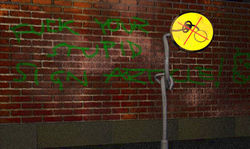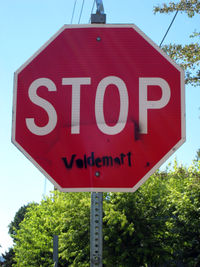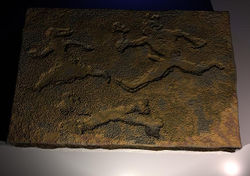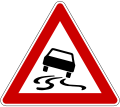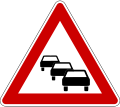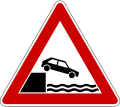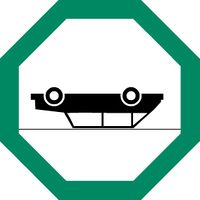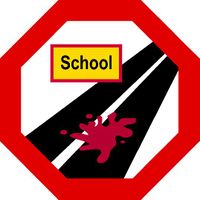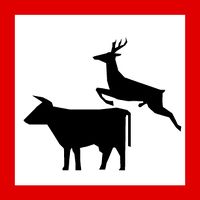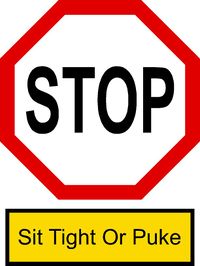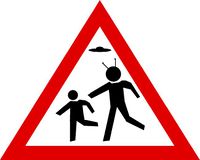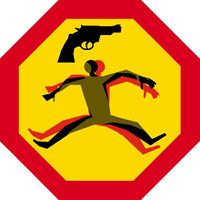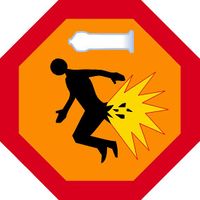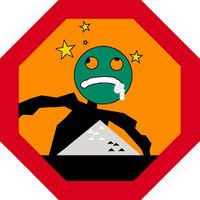Traffic sign
“Signs? That crappy Mel Gibson film? No, the other one....”
The vast majority of countries worldwide post signage, known as traffic signs, at the side of roads and specific areas of concern to warn of potential danger, to impart useful information and to provide guidance for smugglers, thieves and illegal immigrants. The creation and unkeep of traffic signs has, since 1969, fallen under the remit of the Health and Safety Gestapo.
History
Early Middle Ages
One of the most famous early Middle Ages signs that has survived is the "No Raping" sign from the escavation at Sutton Hoo. This 8th century English sign carved in stone contains easily recognisable images and was intended as a warning to passing Vikings. Historians agree it was comparably ineffective, probably due to interpretational problems. A red cross on top of a subject, to imply a prohibited action, is a fairly recent invention. The crossed bones used for substitute in the sign in question did not have the same effect on the Vikings, who took them as a favourable sign and raped even those they hadn't intended to. Similar efforts to convey the message to the Vikings were repeated time after time, but none of them was effective. Another example is a wooden sign that has survived in the Church of Arseleagh. It has similar problems to the stone sign: the Vikings were illiterate almost to a man, and took such signs for a welcome, or ignored them altogether.
Late Middle Ages, Renaissance
The world during the Middle Ages was rife with traffic signs carved in wood or stone, sometimes inlaid with copper, or in the better neighbourhoods, even with silver or gold. Everything had to be expressed in images since few people could read or think clearly.
In 1640, Galileo Galilei invented the red cross to imply a prohibited action. The amount of work leading to the invention taxed his health severely, and he died only two years later. He was not bitter, however. In his final letter to his bookkeeper, he mentioned the idea as "the one I would have myself remembered by".
The most famous Renaissance signs were carved by Grinling Gibbons, the English master carver. Originally he was a Dutch master, but he was not safe in continental Europe after carving a sign that mocked the government. Grinling's traffic signs are among the victims of the numerous revolts in the British Isles: being made of wood they easily caught fire. We only have a verbal account of what they were like:
"Gibbons had an outstanding ability to shape traffic signs. He had a style that set him clearly apart from other traffic sign carvers. Yew was his favorite wood. Even the simplest "In case of fire, break this pig's bladder covering" -sign was filled with fruits, lucky signs, leaves and an occasional violin or cherub. It is really a pity his work was confined to traffic signs."
The Age of Reason
The "Age of Reason" was a challenge to traffic sign designers. Since the number of literate people was still comparably low, and the human society far more complex than during the previous centuries, the ideas the signs needed to convey were accordingly more complex as well. In 1895, King Charles the Wicked decreed a law: anyone failing to obey a traffic sign would be beheaded. The results were catastrophic. More than half of the continental population was wiped out by the executions, and most of the rest fled to America, to the Far East or to Australia. No signs from the era have survived: they were unreasonable, and were destroyed during the Great sign burnage of 1905.
Use of traffic signs in today's urban environment
Naturally, with the advent of the automobile, traffic signs started playing an increasingly important part in traffic. Nowadays roadsides are filled with signs informing the drivers of minimum speed limits, areas to drive over children, and so forth.
Present trends
With the explosion of drug and arms trafficking, modern slave trade and other types of illegal immigration, the need for new sets of traffic signs is pressing. Since there are numerous unwritten laws in the criminal world, clearly those laws should be made understandable to beginners by signs. The following is a series of traffic signs aimed at these problem areas - they are expected to be ratified by the end of 2010.
